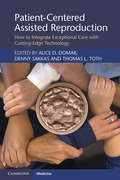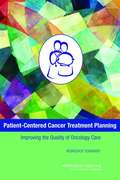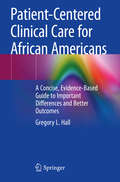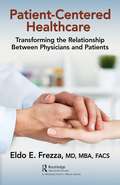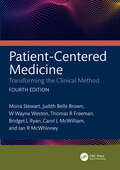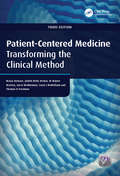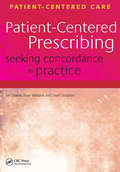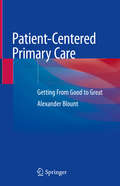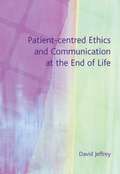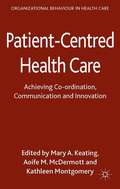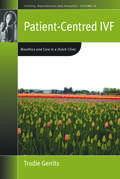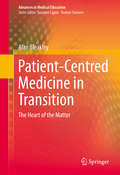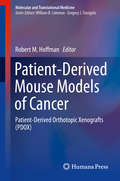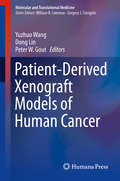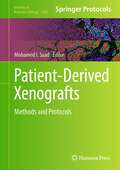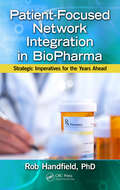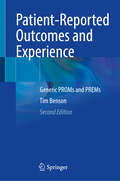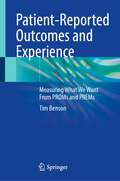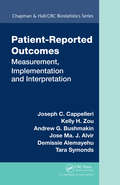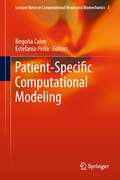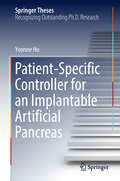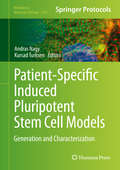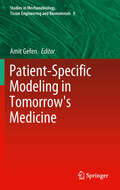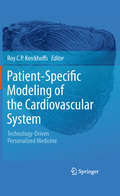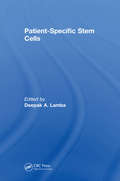- Table View
- List View
Patient-Centered Assisted Reproduction: How to Integrate Exceptional Care with Cutting-Edge Technology
by Denny Sakkas Alice D Domar Thomas L TothAddress the future of innovative reproductive technologies with experts in the fields of IVF, fertility preservation and laboratory advances. This essential resource examines the changing roles of IVF, and moves beyond the basics of reproductive medicine. This book introduces the optimization of care, to improve patient outcomes, whilst facing ethical challenges that accompany new technologies, and applying the patient-centered care model to improve both patient and staff retention. By showcasing the future of the field in terms of clinical practice and innovative laboratory technologies, this guide will support clinics worldwide to provide high-quality customer experience, maintaining a competitive edge, following increasing standardization of clinical and laboratory protocols. This invaluable guide features chapters on patient evaluation, predictive modelling, advances in pharmacology, and laboratories of the future. Written by research and clinical leaders from around the world, it describes ground-breaking innovative treatments and technologies, encompassing the care model in a holistic way.
Patient-Centered Cancer Treatment Planning: Improving the Quality of Oncology Care
by The National Academy of SciencesEach year approximately 1. 5 million people are diagnosed with cancer in the United States, most of whom inevitably face difficult decisions concerning their course of care. Recognizing challenges associated with cancer treatment, the National Coalition for Cancer Survivorship (NCCS) and the National Cancer Policy Forum (NCPF) of the Institute of Medicine (IOM) hosted a public workshop in Washington, DC on February 28 and March 1, 2011, entitled Patient-Centered Cancer Treatment Planning: Improving the Quality of Oncology Care. This workshop summary includes an overview of patient-centered care and cancer treatment planning, as well as subject areas on shared decision making, communication in the cancer care setting, and patient experiences with cancer treatment. Best practices, models of treatment planning, and tools to facilitate their use are also discussed, along with policy changes that may promote patient-centeredness by enhancing patient's understanding of and commitment to the goals of treatment through shared decision-making process with their healthcare team from the moment of diagnosis onward. Moreover, Patient-Centered Cancer Treatment Planningemphasizes treatment planning for patients with cancer at the time diagnosis.
Patient-Centered Clinical Care for African Americans: A Concise, Evidence-Based Guide to Important Differences and Better Outcomes
by Gregory L. HallThis title is an easy-to-read guide outlining specific differences in communication, clinical therapies, medications, protocols, and other critical approaches to the care of African Americans. The book discusses a wide range of disorders impacting African Americans and takes a comprehensive and evidence-based approach to the clinical support of providers that see African American patients. Recording the worst medical outcomes of any racial/ethnic group in America, African Americans have the highest mortality, longest hospital length of stay, worst compliance with medications and referrals, and the lowest trust of the healthcare system. Indeed, there are countless well-designed studies that validate verified differences in the clinical care of a number of pervasive diseases in African Americans, including hypertension, heart disease, kidney disease, obesity, cancer, and more. Despite the widespread acknowledgement of the existence of health disparities among racial/ethnic groups, the overall outcomes for African Americans are still the most shocking. From high infant mortality to death by almost any cause, African Americans have the worst data of any other racial or ethnic group. Patient-Centered Clinical Care for African Americans, a highly practical and first-of-its-kind title, illuminates these alarming issues and represents a major contribution to the clinical literature. It will be of significant interest to all physicians, clinicians, and allied health personnel.
Patient-Centered Healthcare: Transforming the Relationship Between Physicians and Patients
by Eldo FrezzaPatient-centered care is a way of thinking and doing things that considers patients partners in the development of a healthcare plan designed to meet their specific needs. It involves knowledge of the individual as a person and integrates that knowledge into their plan of care. Patient-centered care is central to the discussion of healthcare at the insurance and hospital-level. The quality of the service is evaluated more deeply from all the healthcare components, including insurance payments. It is the start of a new client- and patient-centered healthcare, which is based on a profound respect for patients and the obligation to care for them in partnership with them. Healthcare has been lacking a strategy to teach patients how to take care of themselves as much as they possibly can. In countries with socialized healthcare, patients don’t go to the emergency room unless it is necessary; they have a physician on call instead. This affords more personalized care and avoids patients getting lost in the hospital system. This book advocates the critical role of patients in the health system and the need to encourage healthy living. We need to educate patients on how to be more self-aware, giving them the tools to better understand what they need to do to achieve healthy lifestyles, and the protocols and policies to sustain a better life. Prevention has always been the pinnacle of medical care. It’s time to highlight and share this approach with patients and involve them as active participants in their own healthcare. This is the method on which to build the new healthcare for the next century.
Patient-Centered Medicine: Transforming the Clinical Method
by Moira Stewart Judith Belle Brown Ian R. McWhinney Carol L. McWilliam Thomas Freeman W. Wayne Weston Bridget L. RyanThe Patient-Centered Clinical Method (PCCM) has been a core tenet of the practice and teaching of medicine since the first edition of Patient-Centered Medicine - Transforming the Clinical Method was published in 1995. This timely fourth edition continues to define the principles underpinning the patient-centered clinical method using four major components, clarifying its evolution and consequent development, and it brings the reader fully up to date. It reinforces the relevance of the method in the current much-changed realities of health care in a world where virtual care will remain common, dependence on technology is rising, and societal changes away from compassion, equity, and relationships toward confrontation, inequity, and self-absorption.Fully revised by its highly experienced author team ensuring wide interest and written for those practising now and for the practitioners of the future, this new edition will be welcomed by a wide international audience comprising all health professionals from medicine, nursing, social work, occupational therapy, physical therapy, pharmacy, veterinary medicine, and other fields.
Patient-Centered Medicine: Transforming the Clinical Method
by Moira Stewart Judith Belle Brown Wayne Weston Ian R. McWhinney Carol L. McWilliam Thomas FreemanThis long awaited Third Edition fully illuminates the patient-centered model of medicine, continuing to provide the foundation for the Patient-Centered Care series. It redefines the principles underpinning the patient-centered method using four major components - clarifying its evolution and consequent development - to bring the reader fully up-to-
Patient-Centered Prescribing: Seeking Concordance in Practice (Radcliffe Ser.)
by Brian Williams Jon Dowell David SnaddenSeries Editors: Moira Stewart, Judith Belle Brown and Thomas R Freeman Half of all prescribed medicines are used in a sub-optimal manner and clinicians struggle to find ways of improving the situation. There is a move towards greater partnership with patients, but concordance (shared decision making between patients and healthcare professionals) is a growing challenge for the profession. This practical book offers numerous real life case studies to demonstrate the way the patient-centered model, combined with other behavioural models, can result in a logical approach to prescribing for difficult clients, including 'non-compliant' and other challenging patients. Patient-Centered Prescribing fully considers the very complex nature of the issues at hand, ethical questions, time restrictions and financial matters, to produce a realistic analysis of the difficulties to be overcome in achieving better practice. This book is ideal for doctors, nurses and pharmacists, and postgraduate students of medicine, pharmacy and nursing. It is also of great interest to medical educators, particularly those teaching primary care and communication skills, and to everyone involved in developing doctor-patient partnerships.
Patient-Centered Primary Care: Getting From Good to Great
by Alexander BlountThere have been great strides made in designing the administrative structures of patient-centered care, but it is still difficult to design truly patient-centered clinical routines that the entire healthcare team can enact. The kind of partnership, in which patients are fully part of the team that guides their own care, goes against so much of the training and socialization of health professionals and, for that matter, the expectations of many patients. This is particularly true for patients we sometimes call “complex.” In other contexts, we call them “high utilizers,” “disadvantaged,” “heartsink patients,” or “people with trauma histories.” Blount calls them “multiply-disadvantaged” patients. To successfully serve these patients requires our best versions of team-based care, including behavioral health and care management team members, though every member of the team needs help in engaging these patients and mutual support in adapting to the rapid changes in roles that new team approaches are creating. This book offers a summary of the approaches that are currently in growing use, such as health literacy assessment, motivational interviewing, appreciative inquiry, shared decision making, minimally disruptive care, trauma informed care, enfranchisement coaching, relationship-centered care, and family-informed care. Finally, it offers a transformative method, based on familiar elements, that is Transparent, Empowering, Activating, and Mutual: the T.E.A.M. Way.
Patient-Centred Ethics and Communication at the End of Life
by David JeffreyThis book provides the best information available on the ways priorities are currently set for health care around the world. It describes the methods now used in the six countries leading the process, and contrasts the differences between them. It shows how, except in the UK, frameworks have now been developed to set priorities. Making Choices for Health Care sets forth the key issues that need to be tackled in the years ahead. Descriptions of the leading trends are accompanied by suggestions to resolve outstanding difficulties. Topics include: the need for national research and development funding for new treatments, ways to shift resources permanently towards prevention and chronic care, and how DALYs may replace QALYs. While the concepts and values underlying priority setting have been discussed elsewhere, Making Choices for Health Care highlights real current practice. It is a vital tool for policy-makers, health care managers, clinicians, patient organizations, academics, and executives in pharmaceutical and medical supply industries.
Patient-Centred Health Care
by Mary A. Keating Aoife M. Mcdermott Kathleen MontgomeryThere are four core themes developed in this book which deal with critical issues, models, theories and frameworks. These expound understandings of patient centred care and the processes, practices and behaviours supporting its attainment: conceptions and cultures of patient-centred care, coordination, communication, innovation.
Patient-Centred IVF: Bioethics and Care in a Dutch Clinic
by Trudie GerritsContemporary Dutch policy and legislation facilitate the use of high quality, accessible and affordable assisted reproductive technologies (ARTs) to all citizens in need of them, while at the same time setting some strict boundaries on their use in daily clinical practices. Through the ethnographic study of a single clinic in this national context, Patient-Centred IVF examines how this particular form of medicine, aiming to empower its patients, co-shapes the experiences, views and decisions of those using these technologies. Gerrits contends that to understand the use of reproductive technologies in practice and the complexity of processes of medicalization, we need to go beyond 'easy assumptions' about the hegemony of biomedicine and the expected impact of patient-centredness.
Patient-Centred Medicine in Transition
by Alan BleakleyThis book challenges functional models for more aesthetic and ethical models, where communication is grounded in values systems of cultures. Here, communication is treated as a distributed phenomenon involving networks of persons, activities and artifacts, and extends beyond doctor-patient relationships to working in and across teams around patients. The purpose of the book is to stimulate thinking about how patient care and safety may be improved through a focus upon the 'non-technical' work of doctors - interpersonal communication, teamwork and situation awareness in teams. The focus is then not on the personality of the doctor, but on the dynamics of relationships which form doctors' multiple identities.
Patient-Derived Mouse Models of Cancer
by Robert M. HoffmanThis text highlights seminal discoveries and also provides comprehensive and state-of the-art approach to mouse models of human patient tumors. These areas include training, basic techniques, as well as general troubleshooting. Subsequent chapters focus on the different mouse models of patient tumors including the various strains of immunodeficient mice currently available and the transplantation techniques that can be used as well as state-of-the-art imaging techniques. Practical applications of the models from drug discovery, genome analysis to personalized treatment are also covered. Written by experts in that field, each of these sections address these critical issues. A brief review of the existing literature addressing the particular topic follows in each section. Presently, there is no single source to provide information on technique and uses of mouse models of human patient tumors. Patient-Derived Mouse Models of Cancer will satisfy this need for cancer researchers, oncologists, pharmaceutical and biotechnology industry scientists as well as molecular biologists studying in vivo systems
Patient-Derived Xenograft Models of Human Cancer
by Dong Lin Yuzhuo Wang Peter W. GoutThis book provides a comprehensive, state-of-the-art review of PDX cancer models. In separately produced chapters, the history and evolution of PDX models is reviewed, methods of PDX model development are compared in detail, characteristics of available established models are presented, current applications are summarized and new perspectives about use of PDX models are proposed. Each chapter is written by a world-renowned expert who is conducting cutting-edge research in the field. Each of the subsections provide a comprehensive review of existing literature addressing the particular topic followed by a conclusive paragraph detailing future directions. Extensive illustrations make this an interactive text. Patient-Derived Xenograft Models of Human Cancer will serve as a highly useful resource for researchers and clinicians dealing with, or interested in, this important topic. It will provide a concise yet comprehensive summary of the current status of the field that will help guide preclinical and clinical applications as well as stimulate investigative efforts. This book will propagate innovative concepts and prompt the development of ground-breaking technological solutions in this field.
Patient-Derived Xenografts: Methods and Protocols (Methods in Molecular Biology #2806)
by Mohamed I. SaadThis detailed volume explores the dynamic landscape of patient-derived xenograft (PDX) generation and applications. After a few chapters examining the evolution of PDXs, tracing their roots and contextualizing their significance in the broader narrative of cancer research, the book continues with methodologies for generating PDXs from diverse clinical tissue samples as well as for utilizing PDXs in various specific cancer types. From the development of humanized PDX models to the exploration of protein expression through advanced techniques including multiplex immunohistochemistry, Western blotting, and immunoprecipitation, the chapters offer a comprehensive toolkit for researchers and clinicians alike. Written for the highly successful Methods in Molecular Biology series, chapters include introductions to their respective topics, lists of the necessary materials and reagents, step-by-step and readily reproducible laboratory protocols, and tips on troubleshooting and avoiding known pitfalls. Authoritative and practical, Patient-Derived Xenografts: Methods and Protocols serves as an ideal interdisciplinary guide for understanding the intricate processes that underscore translational cancer research.
Patient-Focused Network Integration in BioPharma: Strategic Imperatives for the Years Ahead
by Robert HandfieldThe biopharmaceutical industry as we know it today is going through a massive upheaval as a result of the uncertainty of healthcare reform and increasing regulatory pricing pressure. A wake-up call to all sectors of the healthcare value chain, Patient-Focused Network Integration in BioPharma: Strategic Imperatives for the Years Ahead explores patient-focused network integration as quite possibly the only way for organizational evolution to occur. The book discusses how to align enterprises with the patient at the center. It details the historical context of the biopharmaceutical value chain and the current set of challenges facing the industry, and then details the author’s unique and sustainable agenda for change.The book traces the critical but often ignored relationships between hospitals, insurance companies, biopharma manufacturers, government regulators, and clinical scientists. For too long, these parties have been operating in a void, without recognizing the interconnectedness of their objectives, even though these objectives are often competing and misaligned. This book points out the gaps that exist and develops a set of recommendations regarding disease treatments, clinical development of new products, and collaboration between these players that can result in a sustainable solution to the healthcare mess. Each chapter can be viewed as an independent essay, in that it deals with a specific dimension of the healthcare value chain. However, together they provide an integrated discussion on how to begin the task of creating an integrated value chain network for healthcare. The book begins with the patient, and then works its way back down the value chain, all the way to the drug development and clinical trials stage of the value chain. The common thread throughout the chapters is the emphasis on collaboration, strategic alignment, and a focus on delivering value to the end patient.Very simply, all parties in the healthcare value chain network must align their strategic planning to derive innovation solutions. It is only through true collaboration and aligned thinking that the parties in the drug development, distribution, insurance payors, and hospital provider network can deal with the incredible complexity and massive challenges that face the industry. The book provides a compelling maturity model that enables readers to gauge the level of network integration their enterprise is at today, and where they need to move in the future.
Patient-Reported Outcomes and Experience: Generic PROMs and PREMs
by Tim BensonThis revised edition shows how patient-reported outcome models (PROMs) and patient-reported experience models (PREMs) can help improve health outcomes and patient experience. The first section covers the core principles of PROMs and PREMs, including their strengths and weaknesses, reporting and analysis, while the second section covers measures of patient experience, health status, wellbeing, self-efficacy, individualized measures, social determinants of health, and impact evaluation. The final section covers topics such as noise, interoperability and quality-adjusted life years. Patient-Reported Outcomes and Experience: Generic PROMs and PREMs covers how to use these measures to improve the outcomes of healthcare services and associated patient experience. It is a critical resource for clinicians, managers, analysts and policymakers seeking an up-to-date reference on the latest developments in this rapidly expanding field.
Patient-Reported Outcomes and Experience: Measuring What We Want From PROMs and PREMs
by Tim BensonThis book shows how PROMs and PREMs can help improve patient experience and outcomes. Part 1 covers the core principles of PROMs and PREMs, including their strengths and weaknesses, reporting and analysis, data sharing and valuation. Part 2 covers measures of patient experience, health status, wellbeing, self-efficacy, individualized measures, social determinants of health and impact evaluation. It concludes with a discussion of staff-reported measures, proxies and caregivers. Patient-Reported Outcomes and Experience: Measuring What We Want with PROMs and PREMs concisely covers how to use these measures successfully to improve patient experience of healthcare services and associated outcomes. It is a critical resource for trainee and practicing clinicians, managers, analysts and policymakers seeking an up-to-date reference on the latest developments in this rapidly expanding field.
Patient-Reported Outcomes: Measurement, Implementation and Interpretation (Chapman & Hall/CRC Biostatistics Series)
by Joseph C. Cappelleri Demissie Alemayehu Kelly H. Zou Andrew G. Bushmakin Jose Ma. Alvir Tara SymondsHowever, exciting new developments are on the verge of changing the treatment of this debilitating disorder. Two anabolic agents, the parathyroid hormone (PTH) and the fluoride ion, show tremendous promise as tools for building and retaining bone - with no adverse side effects. Anabolic Treatments for Osteoporosis is a comprehensive account of the latest studies that have been carried out on these two agents, and a thorough assessment of their prospects as osteoporosis therapeutics. This unique book combines basic science and up-to-date clinical data to present a complete picture of this breakthrough in the treatment of a globally significant health issue.
Patient-Specific Computational Modeling
by Begoña Calvo Lopez Estefanía PeñaThis book addresses patient-specific modeling. It integrates computational modeling, experimental procedures, imagine clinical segmentation and mesh generation with the finite element method (FEM) to solve problems in computational biomedicine and bioengineering. Specific areas of interest include cardiovascular problems, ocular and muscular systems and soft tissue modeling. Patient-specific modeling has been the subject of serious research over the last seven years and interest in the area is continually growing and this area is expected to further develop in the near future.
Patient-Specific Controller for an Implantable Artificial Pancreas (Springer Theses)
by Yvonne HoThe thesis focuses on the control of blood glucose devices and design of implantable devices, and offers valuable insights on diabetes mellitus and related physiology and treatments. Diabetes mellitus is a widespread chronic disease in the modern world that affects millions of people around the globe. In Singapore, one in ten of the population has diabetes, and the severity of the problem has prompted the country’s prime minister to talk about the disease at the National Day Rally in 2017. Designing an artificial pancreas that can provide effective blood glucose control for individuals with diabetes is one of the most challenging engineering problems. The author reports on research into the development of an implantable artificial pancreas that can regulate blood glucose levels by delivering appropriate dosages of insulin when necessary. By sensing blood glucose and injecting insulin directly into the vein, the implantable device aims to remove delays that occur with subcutaneous blood glucose sensing and insulin delivery. Preliminary in-vitro and in-vivo experimental results suggest that the implantable device for blood glucose control could be a clinically viable alternative to pancreas transplant.
Patient-Specific Induced Pluripotent Stem Cell Models
by Kursad Turksen Andras NagyThis volume captures the rapid developments in the field of induced pluripotent stem (iPS) cells, which have provided novel opportunities and approaches both for better understanding a number of human diseases and for developing new platforms for drug development and screening for such diseases. Specifically, representative protocols on various disease models have been collected from labs around the world. Written for the highly successful Methods in Molecular Biology series, chapters include introductions to their respective topics, lists of the necessary materials and reagents, step-by-step, readily reproducible laboratory protocols, and tips on troubleshooting and avoiding known pitfalls. Authoritative and practical, Patient-Specific Induced Pluripotent Stem Cell Models: Generation and Characterization is an ideal reference for scientists working on furthering iPS research.
Patient-Specific Modeling in Tomorrow's Medicine
by Amit GefenThis book reviews the frontier of research and clinical applications of Patient Specific Modeling, and provides a state-of-the-art update as well as perspectives on future directions in this exciting field. The book is useful for medical physicists, biomedical engineers and other engineers who are interested in the science and technology aspects of Patient Specific Modeling, as well as for radiologists and other medical specialists who wish to be updated about the state of implementation.
Patient-Specific Modeling of the Cardiovascular System
by Roy C.P. KerckhoffsThe main purpose of the book is to demonstrate the design of a variety of patient-specific models within the cardiovascular system in computational biology. The maturation of computational biology could lead to a new approach to medicine. During the last five to ten years, there have been many improvements in diagnostic medical technologies such as multi-slice cardiac CT imaging, 3-D electroanatomic mapping, and many types of applications of Magnetic Resonance Imaging (i.e. magnetic resonance tagging and diffusion tensor imaging). Combined with more powerful computing resources and more accurate predictive computational models it is feasible to begin developing mechanistic patient-specific models that may help diagnosis, guide therapy or surgery, and predict outcomes of the latter. Many questions need to be answered before computational modeling can be fully integrated with standard care, such as what is the minimal data set needed from the patient in order to build a reliable predictive model? What accuracy is needed? How will the initial baseline model be validated? What are reasonable computation times? Is some type of perturbation of the patient's physiology necessary? How could they be integrated with current practices? Are physicians willing to accept these models? These questions will also serve as guidelines throughout the chapters. The book will try to cover, such as cardiac electrophysiology, cardiac (muscle) mechanics, circulation dynamics, arterial and venous flow, angiogenesis, remodeling, metabolism, or combinations between these such as cardiac electromechanics or fluid-solid interactions.
Patient-Specific Stem Cells
by Deepak A. LambaOne of the biggest challenges faced in medical research had been to create accurate and relevant models of human disease. A number of good animal models have been developed to understand the pathophysiology. However, not all of them reflect the human disorder, a classic case being Usher’s syndrome where the mutant mice do not have the same visual and auditory defects that patients face. There are others which have been even more difficult to model due to the multi-factorial nature of the condition and due to lack of discovery of a single causative gene such as age-related macular degeneration or Alzheimer’s syndrome. Thus a more relevant and accurate system will allow us to make better predictions on relevant therapeutic approaches. <P><P>The discovery of human pluripotent stem cells in 1998 followed by the technological advances to reprogram somatic cells to pluripotent-stem cell-like cells in 2006 has completely revolutionized the way we can now think about modelling human development and disease. This now coupled with genome editing technologies such as TALENS and CRISPRs have now set us up to develop in vitro models both 2D as well as 3D organoids, which can more precisely reflect the disease in the patients. These combinatorial technologies are already providing us with better tools and therapeutics in drug discovery or gene therapy. <P><P>This book summarizes both the technological advances in the field of generation of patient specific lines as well as various gene editing approaches followed by its applicability in various systems. The book will serve as a reference for the current state of the field as it: <li>Provides a comprehensive overview of the status of the field of patients derived induced pluripotent stem cells. <li>Describes the use of cardiac cells as a main featured component within the book. <li>Examines drug toxicity analysis as a working example throughout the book.
